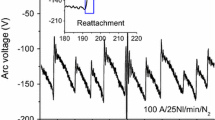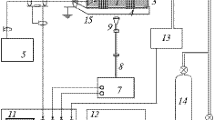Abstract
The time-dependent evolution of the energy transfer into gas heating in the afterglow of pulsed CO2 and CO2–N2 glow discharges produced in cylindrical tubes at low pressures (1–5 Torr) is theoretically investigated, by developing a self-consistent model that couples the time-dependent gas thermal balance equation with the vibrational kinetics. The modelling predictions are in good agreement with recently published experimental data on gas temperature, obtained via time-resolved in situ Fourier transform infrared spectroscopy. The cooling of the gas in the afterglow is found to be strongly dependent on the thermal conductivity and the wall temperature. It is verified that wall and volume deactivation of CO2 vibrationally excited species influences the gas heating along the afterglow, in different proportions depending on the pressure of the gas. The time-resolved contributions of each of these cooling and heating mechanisms are discussed in detail. The new results bring an additional validation of a set of mechanisms and rate coefficients for vibrationally-energy transfers previously proposed.







Similar content being viewed by others
References
Goede APH, van de Sanden R (2016) CO2-neutral fuels. Europhys News 47(3):22–26
Bogaerts A, Neyts EC (2018) Plasma technology: an emerging technology for energy storage. ACS Energy Lett 3:1013–1027
Snockx R, Bogarts A (2017) Plasma technology—a novel solution for CO2 conversion? Chem Soc Rev 46:5805–5863
Kozák T, Bogaerts A (2014) Splitting of CO2 by vibrational excitation in non-equilibrium plasmas: a reaction kinetics model. Plasma Sources Sci Technol 23:1–17
Capitelli M, Colonna G, Ammando GD, Pietanza LD (2017) Self-consistent time dependent vibrational and free electron kinetics for CO2 dissociation and ionization in cold plasmas. Plasma Sources Sci Technol 26:1–17
Berthelot A, Bogaerts A (2016) Modeling of plasma-based CO2 conversion: lumping of the vibrational levels. Plasma Sources Sci Technol 25:1–22
Diomede P, Van De Sanden MCM, Longo S (2017) Insight into CO2 dissociation in plasmas from numerical solution of a vibrational diffusion equation. J Phys Chem C. https://doi.org/10.1021/acs.jpcc.7b04896
Silva T, Grofulovic M, Terraz L, Pintassilgo CD, Guerra V (2018) Modelling the input and relaxation of vibrational energy in CO2 plasmas. J Phys D Appl Phys 54:464001
Silva T, Grofulovic M, Klarenaar BLM, Morillo-Candas AS, Guaitella O, Engeln R, Pintassilgo CDP, Guerra V (2018) Kinetic study of CO2 plasmas under non-equilibrtium conditions. I. Input of vibrational energy. Plasma Sources Sci Technol 27:115009
Grofulovic M, Silva T, Klarenaar BLM, Morillo-Candas AS, Guaitella O, Engeln R, Pintassilgo CDP, Guerra V (2018) Kinetic study of CO2 plasmas under non-equilibrtium conditions. II. Relaxation of vibrational energy. Plasma Sources Sci Technol 27:015019
Terraz L, Silva T, Morillo-Candas AS, Guaitella O, Tejero-del-Caz A, Alves LL, Guerra V (2019) Influence of N2 on the CO2 vibrational distribution function and dissociation yield in non-equilibrium plasmas. J Phys D Appl Phys 53:094002
Grofulovic M, Alves LL, Guerra V (2016) Electron-neutral scattering cross sections for CO2: a complete and consistent set and assessment of dissociaiton. J Phys D Appl Phys 49:395207
Ozkan A, Dufour T, Silva T, Britun N, Snyders R, Bogaerts A, Reniers F (2016) The influence of power and frequency on the filamentary behavior of a flowing DBD—application to the splitting of CO2. Plasma Sources Sci Technol 25:25013
Pinhão NP, Janeco A, Branco JB (2011) Influence on helium on the concersion of methane and carbon dioxide in a dielectric barrier discharge. Plasma Chem Plasma Process 31:427–439
Scapinello M, Martini LM, Dilecce G, Tosi P (2016) Conversion of CH4/CO2 by a nonsecond repetitively pulsed discharge. J Phys D Appl Phys 49:075602
Silva T, Britun N, Godfroid T, Snyders R (2014) Optical characterization of a microwave pulsed discharge used for dissociation of CO2. Plasma Sources Sci Technol 23:25009
Silva T, Britun N, Godfroid T, Mullen J, Snyders R (2016) Study of Ar and Ar–CO2 microwave surfaguide discharges by optical spectroscopy. J Appl Phys 119:173302
Chen G, Silva T, Georgieva V, Godfroid T, Britun N, Snyders R, Delplancke-Ogletree MP (2015) Simultaneous dissociation of CO2 and H2O to syngas in a surface-wave microwave discharge Int. J Hydrog Energy 40:3789–3796
Klarenaar BLM, Engeln R, van den Bekerom DCM, van de Sanden MCM, Morillo-Candas AS, Guaitella O (2017) Time evolution of vibrational temperatures in a CO2 glow discharge measured with infrared absorption spectroscopy. Exp Methods Plasma Sources Sci Technol 26:1–11
Morillo-Candas AS, Drag C, Booth JP, Dias TC, Guerra V, Guaitella O (2019) Oxygen atom kinetics in CO2 plasmas ignited in a DC glow discharge. Plasma Sources Sci Technol 28:075010
Spencer LF, Gallimore A (2011) Efficiency of CO2 dissocaition ina radio-frequency discharge. Plasma Chem Plasma Process 31:79–89
Nunnally T, Gutsol K, Rabinovich A, Fridman A, Futsol A, Kemoun A (2011) Dissociation of CO2 in a low current gliding arc plasmatron. J Phys D Appl Phys 44:274009
Heijkers S, Snoeckx R, Kozák T, Silva T, Godfroid T, Britun N, Snyders R, Bogaerts A (2015) CO2 conversion in a microwave plasma reactor in the presence of N2: modelling and experimental validation. J Phys Chem C 119:12815–128828
Heijkers S, Martini LC, Dilecce G, Tosi P, Bogaerts A (2019) Nanosecond pulsed dicharge for CO2 conversion: kinetic modeling to elucidate the chemistry and improve the performance. J Phys Chem C 123:12104–12116
Guerra V, Silva T, Ogloblina P, Grofulovic M, Terraz L, Lino da Silva ML, Pintassilgo CD, Alves LL (2017) The case for in situ resource utilisation for oxygen production on Mars by non-equilibrium plasmas. Plasma Sour Sci Technol 26:11LT01
Premathilake D, Outlaw RA, Quinlan RA, Byvik CE (2018) Oxygen generation by carbon dioxide glow discharge and separation by permeation through ultrathin silver membrans. Earth Space Sci 6:1–8
Armenise I, Kustova EV (2013) State-to-state models for CO2 molecules: from the theory to an application to hypersonic boundary layers. Chem Phys 415:269–281
Chen G et al (2019) A CO and CO2 tolerating (La0.9Ca0.1)2(Ni0.75Cu0.25)O4+δ Ruddlesden–Popper membrane for oxygen separation. Front Chem Sci Eng. https://doi.org/10.1007/s11705-019-1886-0
Koizumi K, Boero M, Shigeta Y, Oshiyama A (2013) Atom-scale reaction pathways and free-energy landscapes in oxygen plasma etching of graphene. J Phys Chem Lett 4:1592–1596
Adamovich et al (2017) The 2017 plasma roadmap: low temperature plasma science and technology. J Phys D Appl Phys 50:323001
van Rooij GJ, Akse HN, Bongers WA, van de Sanden MCM (2018) Plasma for electrification of chemical industry: a case study on CO2 reduction. Plasma Phys Control Fusion 60:014019
Morillo-Candas AS, Silva T, Klarenaar BLM, Grofulovic M, Guerra V, Guaitella O (2019) Electron impact dissociation of CO2. Plasma Sources Sci Technol. https://doi.org/10.1088/1361-6595/ab6075
Kotov V, Koelman PMJ (2019) Plug flow reactor model of the plasma chemical conversion of CO2. Plasma Sources Sci Technol 28:095002
Pintassilgo CD, Guerra V, Guaitella O, Rousseau A (2014) Study of gas heating mechanisms in milisecond pulsed discharges and afterglows in air at low pressures. Plasma Sources Sci Technol 23:025006
Guerra V, Tatarova E, Dias FM, Ferreira CM (2002) On the self-consistent modeling of a traveling wave sustained nitrogen discharges. J Appl Phys 91:2648
Hanley HJM, Ely JF (1973) The viscosity and thermal conductivity coefficients of dilute nitrogen and oxygen. J Phys Chem Ref Data 2:735
Vesovic et al (1990) The transport properties of carbon dioxide. J Phys Chem Ref Data 19:763
Chase MW (1998) NIST-JANAF thermochemical tables. J Phys Chem Ref Data 9:1–1951
Joly V, Roblin A (1999) Vibrational relaxation of CO2(m,nl,p) in a CO2–N2 mixture. Part 1: survey available data. Aerosp Sci Technol 4:229–238
Blauer JA, Nickerson GR (1973) A survey of vibrational relaxation rate data for processes important to CO2–N2–H2O infrared plume radiatiion Technical Report. AFRPL-TR-73-57 Ultrasystems, Inc
Kutasi K, Guerra V, Sá P (2010) Theoretical insight into Ar–O2 surface-wave microwave discharges. J Phys D Appl Phys 43:175201
Hirschfelder JO, Curtis CF, Bird RB (1964) Molecular theory of gases and liquids. Wiley, New York
Black G, Wise H, Schechter S, Sharpless RL (1974) Measurements of vibrationally exctited molecules by raman scattering. J Phys D Appl Phys 60:3526–3536
Hiskes JR, Karo AM (1984) Generation of negative ions in tandem high density hydrogen discharges. J Phys D Appl Phys 56:1927–1938
Karo AM, Hiskes JR, Hardy RJ (1984) Vibrational relaxation in H2 molecules by wall collisions: applications to negative ion source processes. J Vac Sci Technol A 3:1222–1228
Marinov D, Guerra V, Guaitella O, Booth JP, Rousseau A (2013) Ozone kinetics in low-pressure discharges: vibrationally excited ozone and molecule formation on surface. Plasma Sources Sci Technol 22:055018
Billing GD, Fisher ER (1979) VV and VT rate coefficients in N2 by a quantum-classical model. Chem Phys 43:395–401
Taylor RL, Bitterman S (1969) Survey of vibrational relaxation data for processes important in the CO2–N2 laser system. Rev Mod Phys 41:26–47
Plonjes et al (2000) Vibrational energy storage in high pressure mixtures of diatomic molecules. Chem Phys 260:353–366
Acknowledgements
This work was partially supported by the Portuguese FCT, under Projects UID/FIS/50010/2019 and PTDC/FIS-PLA/1420/2014 (PREMiERE), and Grant PD/BD/105884/2014 (PD-F APPLAuSE).
Author information
Authors and Affiliations
Corresponding author
Additional information
Publisher's Note
Springer Nature remains neutral with regard to jurisdictional claims in published maps and institutional affiliations.
Rights and permissions
About this article
Cite this article
Silva, T., Grofulović, M., Terraz, L. et al. Dynamics of Gas Heating in the Afterglow of Pulsed CO2 and CO2–N2 Glow Discharges at Low Pressure. Plasma Chem Plasma Process 40, 713–725 (2020). https://doi.org/10.1007/s11090-020-10061-7
Received:
Accepted:
Published:
Issue Date:
DOI: https://doi.org/10.1007/s11090-020-10061-7




